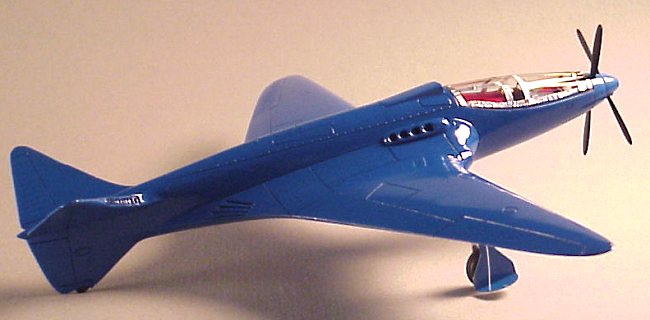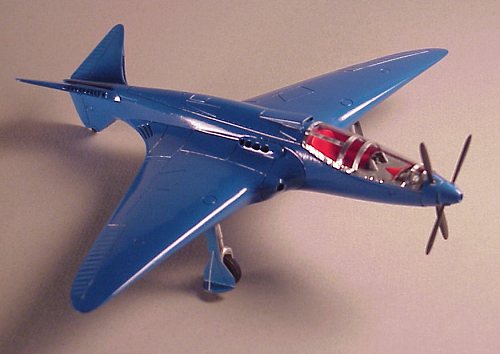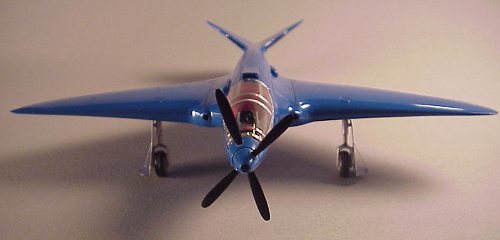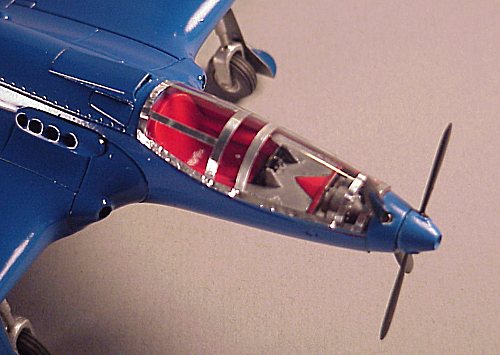 r
rLe Mans Miniatures 1/43 Bugatti Avion 100P
|
KIT # |
|
|
PRICE: |
$79.00 |
|
DECALS: |
None |
|
REVIEWER: |
|
|
NOTES: |
Resin kit |
|
HISTORY |
The Bugatti Model 100 airplane was designed in 1937 by Louis D. de Monge to compete in the famous "Coupe Deutch" air race. Originally designed with a single propeller, it was later fitted with a second engine, located behind the first one, and a second, counter-rotating propeller.
 Although offering many avant-garde design features (inverted Y-tail,
forward-swept wings), the Model 100 would never fly.
Although offering many avant-garde design features (inverted Y-tail,
forward-swept wings), the Model 100 would never fly.
Hidden during World War II, it was then brought to the United States, where its engines were removed and used to power racing cars. Its fuselage, passing from hand to hand, was finally donated to the Experimental Aircraft Association (EAA) museum, in Oshkosh, Wisconsin, which started a restoration project in 1996.
Some experts think this unique aircraft would have set a world record at the time. We will never know if this is true Ė but the Bugatti 100's unique, elegant lines have earned it a spot of honor in the EAA museum.
This history courtesy of http://www.messier-bugatti.com/comppro/historic1b.htm
|
THE KIT |
All right all you aviation experts out there, tell me you knew Bugatti designed a race plane back in the late 1930ís? Tell me again that you wanted a kit of this unusual aircraft for your display case, but didnít know where the heck to find it? I got mine on E-Bay, but itís just as easy to go onto the Le Mans Miniatures website and order yourself one! What you get is a beautiful resin casting airframe in a very popular 1/43 scale, thatís right all you automotive junkies, itís your scale! Le Mans makes a variety of resin automobile kits, mostly esoteric racing cars, and if this kit is an indication of the quality of those kits, I might just build a few.
 A solid
sturdy box contains a one piece casting of the complete airframe, but donít get
your hopes up and think itís going to be an easy build. There are some tricking
and delicate assembly stages that make this kit formidable. A small fret of
photo-etched parts, some great white metal castings, and a very clear canopy
also happen to be in the box. And the tires are a typical rubber type so common
to the car kit crowd but since no others were lying around in my spare parts bin
theyíll do just fine.
A solid
sturdy box contains a one piece casting of the complete airframe, but donít get
your hopes up and think itís going to be an easy build. There are some tricking
and delicate assembly stages that make this kit formidable. A small fret of
photo-etched parts, some great white metal castings, and a very clear canopy
also happen to be in the box. And the tires are a typical rubber type so common
to the car kit crowd but since no others were lying around in my spare parts bin
theyíll do just fine.
The airframe is the finest casting Iíve seen to date, perfect engraving lines and fabric representation of the moving surfaces in a softish soapy-like white resin. Not much bad to say about it, just a light sanding with 600 grit paper to smooth things out before prepping for paint. As a matter of fact, the hardest parts of this kit also require the most care.
∑ The photo etches parts are by Eduard as are some paint masks for the canopy, very delicate etched intake vents are supposed to go into the leading edges of the tail surfaces. They are very fine and need particular care in removing from the fret; once removed they fit into the recesses with ease.
∑ The canopy masks are a judgment call, I think anyone with reasonable skill can make them work, although using silver decal film in fine strips will work just as well with less hassle.
∑ Use some simple assembly techniques, if you have a resin kit or two under your belt, this kit should be a breeze.
After looking at some period photos of the original and the completely restored original hanging in the EAA Museum in Oshkosh Wisconsin, the Le Mans kit is quite an accurate representation of the original, despite the disclaimer in the kitsí instructions, ď Le Mans miniatures is not an airplane specialist, could have fooled me!
|
CONSTRUCTION |
 Most of
the main construction is clean up, just like most resin kits now days. A small
mold line under the empennage was sanded down, that blip was the only flaw in an
otherwise flawless casting. The interior consists of a tub, a gear reduction
device, and a control stick thatís all in resin. A few pieces of photo-etch
supplement the instrument panel and a coming. For some of us who find fitting a
resin interior into a kit a hassle, this interior just falls into place.
Most of
the main construction is clean up, just like most resin kits now days. A small
mold line under the empennage was sanded down, that blip was the only flaw in an
otherwise flawless casting. The interior consists of a tub, a gear reduction
device, and a control stick thatís all in resin. A few pieces of photo-etch
supplement the instrument panel and a coming. For some of us who find fitting a
resin interior into a kit a hassle, this interior just falls into place.
Iím almost embarrassed to say a 10-year-old could have made his kit, and it would still come out looking good. Scott asked for a detailed construction write-up, well, there isnít much to write about except to glue the pieces together. Yes, the photo etching requires some patience; it is some very small and fine stuff, but it all fit without a fuss.
The canopy was a bit fiddly, and it doesnít look quite right to me, but itís easy to pop off and redo, the masks did not perform up to my expectations, or visa versa.
|
PAINT & DECALS |
For those with an aversion to applying decals, this kit is a no-brainer as there are NO decals! The overall color was, as you guessed, French blue; mine was Testors brand in the small bottle like you find in any drug store here in the states. It was a perfect match as compared to the picture on the box top plus it was suitably glossy. The original aircraft was eventually to have a number Ď7í painted on it, but it was never applied, as it was never flown.
|
CONCLUSIONS |
 There
you have it, a very sleek, very old design by a very well know designer of cool
things, Le Mans Miniatures should be congratulated for such a great little kit.
There
you have it, a very sleek, very old design by a very well know designer of cool
things, Le Mans Miniatures should be congratulated for such a great little kit.
The cool-o-meter rating pegs out at a 10, difficulty is about a 7 due to the small fine parts, and the Fun rating is off the scale! If you need to spend some hard-earned cash on a worthy kit, this is the one. Thanks to my wallet and E-bay for this kit.
July 2002
Copyright Modelingmadness.com. All rights reserved.
If you would like your product reviewed fairly and fairly quickly, please contact the editor or see other details in the Note to Contributors.
Back to Reviews Page 2021